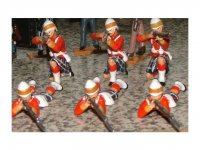theBaron
Major
- Joined
- Mar 27, 2008
- Messages
- 10,526
Well, there are room-temperature-vulcanizing compounds available, but they don't produce molds that last, on average, as long as molds vulcanized under the normal process (which includes application of pressure and heat, if I remember correctly).
My pre-silicon-rubber molding experience? Plaster, when I first attempted to make molds. To keep things easy, I used masters that had no undercuts-an Airfix 1/72 Prussian Landwehrmann standing at attention, for example, and the ensign from the same set, and the old battleship token from Monopoly. And I learned that plaster was only good for a couple of castings, before the heat turned the mold to dust.
Thanks for the pics of the jeweler's centrifuge, it's sort of what I expected it might be, that is, the principles and mechanics are the same, whether it's on that scale, or on the scale of the larger spin casting machines the toy soldier makers use.
Prost!
Brad
My pre-silicon-rubber molding experience? Plaster, when I first attempted to make molds. To keep things easy, I used masters that had no undercuts-an Airfix 1/72 Prussian Landwehrmann standing at attention, for example, and the ensign from the same set, and the old battleship token from Monopoly. And I learned that plaster was only good for a couple of castings, before the heat turned the mold to dust.
Thanks for the pics of the jeweler's centrifuge, it's sort of what I expected it might be, that is, the principles and mechanics are the same, whether it's on that scale, or on the scale of the larger spin casting machines the toy soldier makers use.
Prost!
Brad


